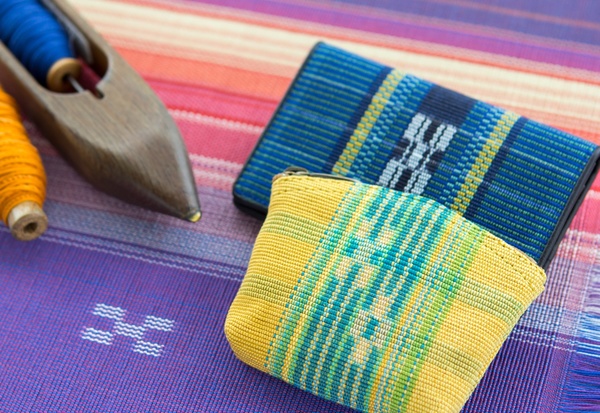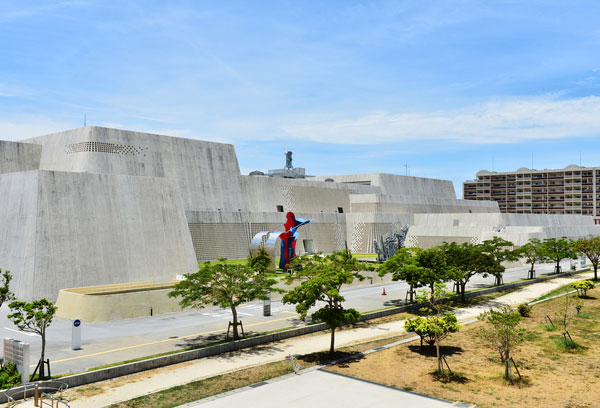
- Woven textiles
- Okinawa
Yaeyama cotton cloth Yaeyama minsa
The indigo blue of the sea and brightly colored plants of Yaeyama
Popular culture is expressed in the simple traditional patterns
Description
What is Yaeyama cotton cloth ?
Yaeyama minsa is a fabric produced in the town of Taketomi, Yaeyama district and the city of Ishigaki, Okinawa prefecture. The origin of this craft is not clear but it is thought that the kasuri belt was brought to Okinawa from Afghanistan via China. The fabric was also used for the kakuobi (men’s stiff sash) of the ryuso (folk costume of Okinawa). This cloth has a ribbed texture with stripes and kasuri patterns woven with cotton threads that have been dyed with indigo for both the warp and weft. Yaeyama minsa has always been woven to make daily wear belts. "Min" means cotton while "sa" means a narrow belt. Kasuri patterns are produced by hand tying and the fabric is in a vivid contrast of navy blue and white. Indigo from India, Ryukyu indigo, kuru (dye extracted from vines grown in Okinawa), plant dyes, including those from the fukugi tree, and more recently chemical dyes are used for Yaeyama minsa. One method of weaving this fabric is to use a takabata (traditional Japanese treadle-operated tall loom) with the reed and the other is to use the tejime method without the reed. The finished belt differs in texture and feel based on the method.
History
It is thought that Yaeyama minsa was brought to Okinawa from Afghanistan via China. On the other hand, some say that the fabric was brought to Okinawa from India where cotton was first made. According to old documents, this fabric was in use during the early 16th century Ryukyu Dynasty, so the fabric is considered to have already been produced at this time. This fabric was given as a gift from women to men as proof of their marriage when they got married at the time when it was standard for the couple not to live together, and the husband visited the wife’s residence occasionally. The pattern looks like a check pattern using four or five squares and the detailed hemming on both sides of the pattern resembles the legs of a centipede. These designs convey the wish that the women had for their husbands to come frequently like a centipede. The design of five and four incorporates the meanings of itsu (meaning whenever which has the same pronunciation as five) and yo (which means both world and four). Therefore, Itsu no yo mademo expresses the meaning of a desire for their husbands to visit forever. The center of Minsa production used to be the town of Taketomi. However, the craft is also now produced on the island of Ishigaki. The fabric used for Minsa used to be only navy blue, but today, a variety of colors as well as various material such as Japanese banana plant, ramie, silk and cotton are used. Accessories, bags and other products are made with Yaeyama minsa fabric and are sold to tourists.
General Production Process
- 1. Warping
Yaeyama minsa is distinctive for using cotton threads for the warp (parallel threads) and the weft (perpendicular threads). First, the number of threads necessary for the warp based on the width of the final product is decided. Then, the lengths of the kasuri threads* that become the pattern, the striped threads that become the white lines and the base threads are decided and arranged based on the design. This process determines the length and the width of the belt. *A textile technique of securely tying specific sections of fabric with thread so that only certain portions will be dyed, which results in a desired pattern.
- 2. Warp tying
When warping is complete, the kasuri threads are spread out in water and prepared for indigo dyeing. For Yaeyama minsa, the warp tying method is used to dye the threads. The threads are marked using a ruler based on the size of the kasuri pattern, and are manually tied where they should be left white to prevent the dye from soaking in. In the past, bark of Japanese fiber banana was used to tie the threads but now vinyl strings are typically used.
- 3. Indigo dyeing
After warp tying, the threads are soaked in water to be cleaned. The threads are spun-dry and separated into the warp threads (base threads and kasuri threads) and the weft threads. As indigo dye colors by oxidation, the threads have to be kneaded in the dye for two to three minutes and taken out to be exposed to the air. This process is repeated until the color deepens enough. Traditional Yaeyama minsa mainly uses indigo dye and dyes from other plants that grow in Yaeyama, including kuru, fukugi, red bayberry and Japanese mallotus.
- 4. Unfastening strings
After the kasuri threads have been dyed, they are left to dry and the strings used for warp tying are unfastened. Then, the length of the base threads and kasuri threads are arranged.
- 5. Adding starch
Starch is added to the threads to even out the tension. This process is necessary because cotton threads stretch easily. The threads should remain the same length so that the pattern is in the correct position. Stakes are hammered on a stone wall of a house and threads are wound around the stakes. Although this work should be done during the day so that the threads can dry, it sometimes takes as long as two days depending on the weather and the length of the thread. This step is essential to make the threads easier to weave and improve the beauty of the woven fabric.
- 6. Temporarily putting threads through a reed
This process involves lining up the base warp threads, kasuri threads, and the striped threads in the shape of the design, individually putting them through the reed, and checking the width of the fabric. The threads are removed before the artisan actually starts weaving so this process is called kari which means ‘temporary’.
- 7. Winding the warp threads
The warp threads temporarily put through the reed are lined up and carefully wound so that the kasuri patterns remain in the correct positions. The threads should not become slack or twisted. The tension in the threads should be kept even so that the kasuri and base threads are pulled with the same amount of strength to weave beautiful fabric.
- 8. Putting the threads through heddle and reed
Wound warp threads are put on the loom and the end of each individual thread is put through the eye of the heddle, and then through the reed. The heddle moves up and down to separate the warp threads for the passage of the weft. Yaeyama Minsa basically uses the technique of plain weaving but it can be changed by using different ways to put the threads through the heddle or reed. When the hand weaving method is used, the threads do not have to be put through the reed so this step can be skipped.
- 9. Weaving
The tension in the warp threads should be kept even and the weft threads are woven between the warp threads using a shuttle. The weft threads are the base threads that were dyed indigo. The woven fabric is washed and inspected to complete the production process.
Where to Buy & More Information
Okinawa Prefectural Museum & Art Museum

-
Address
-
Tel.+81-98-941-8200
-
ClosedMondays (open if Monday is holiday and closed the next day), December 29 - 31
-
Business Hours9am to 6pm Fridays & Saturdays 9am to 8pm
-
Website
See more Woven textiles
- Nishijin brocade
- Yuki tsumugi silk
- Kurume traditional resist-dyed textiles
- Ojiya chijimi textiles
- Hakata brocade
- Ushikubi tsumugi silk
- Chichibu-meisen silk
- Miyako ramie textile
- Shiozawa tsumugi silk
- Kumejima tsumugi silk
- Omi ramie cloth
- Ryukyu traditional resist-dyed textiles
- Kiryu brocade
- Murayama-oshima tsumugi silk
- Yumihama traditional resist-dyed textiles
- Chibana-hanaori textiles
- Hon-shiozawa silk
- Oitama tsumugi silk
- Ojiya tsumugi silk
- Yaeyama cotton cloth
- Yaeyama ramie cloth
- Honba oshima tsumugi silk
- Shinshu tsumugi silk
- Shuri brocade
- Tama brocade
- Yomitanzan-hanaori textiles
- Isesaki traditional resist-dyed textiles
- Hachio island silk
- Nibutani bark cloth
- Uetsu tilia bark cloth
- Awa-shijira cotton cloth
- Kijoka banana fiber cloth
- Tokamachi traditional resist-dyed textiles
- Tokamachi akashi chijimi textiles
- Yonaguni brocade
- Yuntanza minsa
- Flower pattern textiles
- Oku-Aizu Showa Karamushi Textiles
See items made in Okinawa
- Tsuboya ware
- Miyako ramie textile
- Ryukyu lacquerware
- Kumejima tsumugi silk
- Ryukyu traditional resist-dyed textiles
- Chibana-hanaori textiles
- Yaeyama cotton cloth
- Yaeyama ramie cloth
- Shuri brocade
- Yomitanzan-hanaori textiles
- Ryukyu traditional textiles
- Kijoka banana fiber cloth
- Yonaguni brocade
- Yuntanza minsa
- Flower pattern textiles
- Sanshin































































































































































































































































































